Waste Water Treatment: Sustainable Energy & Environmental Benefits
VerifiedAdded on 2023/06/15
|31
|5439
|290
Report
AI Summary
This report explores innovative approaches to waste water treatment, emphasizing its potential for sustainable energy production. It highlights the critical role of waste water treatment in urban environments, where high populations and technological advancements necessitate environmentally friendly solutions. The report discusses the limitations of naturally pure water sources and the importance of treating waste water to mitigate environmental and health risks. It delves into anaerobic digestion techniques, technical and knowledge barriers, and the characteristics of sewage strength. The report also addresses the adverse effects of untreated waste water, such as toxic gas production, water body contamination, and eutrophication. Furthermore, it presents strategies for enhancing energy production from waste water treatment, including the use of bio-organic catalysts and methane capping. The document concludes by outlining the eco-friendly and economic benefits of reprocessed waste water, such as reduced pollution, increased irrigation benefits, and lower operational costs. Desklib provides access to this and other solved assignments for students.
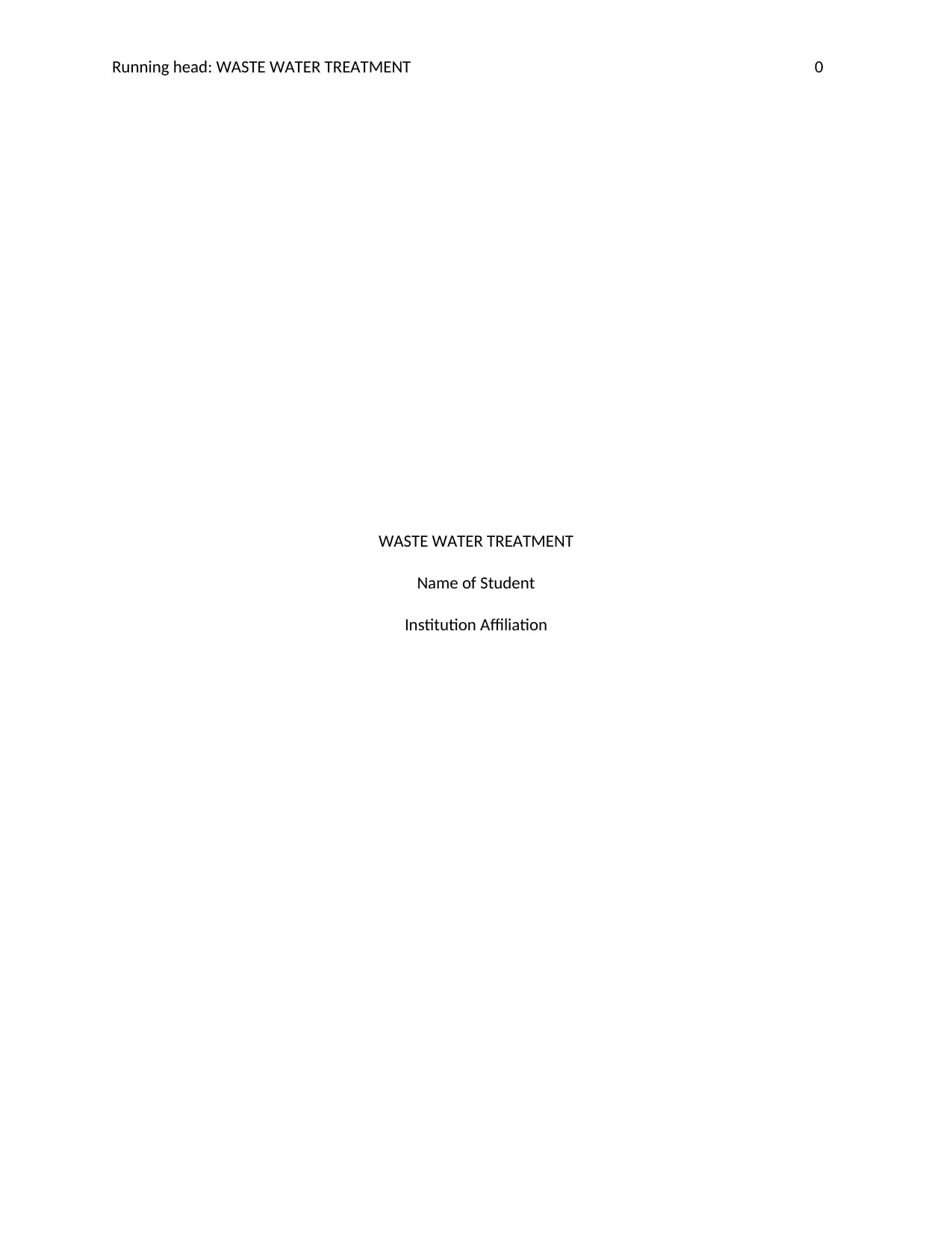
Running head: WASTE WATER TREATMENT 0
WASTE WATER TREATMENT
Name of Student
Institution Affiliation
WASTE WATER TREATMENT
Name of Student
Institution Affiliation
Paraphrase This Document
Need a fresh take? Get an instant paraphrase of this document with our AI Paraphraser
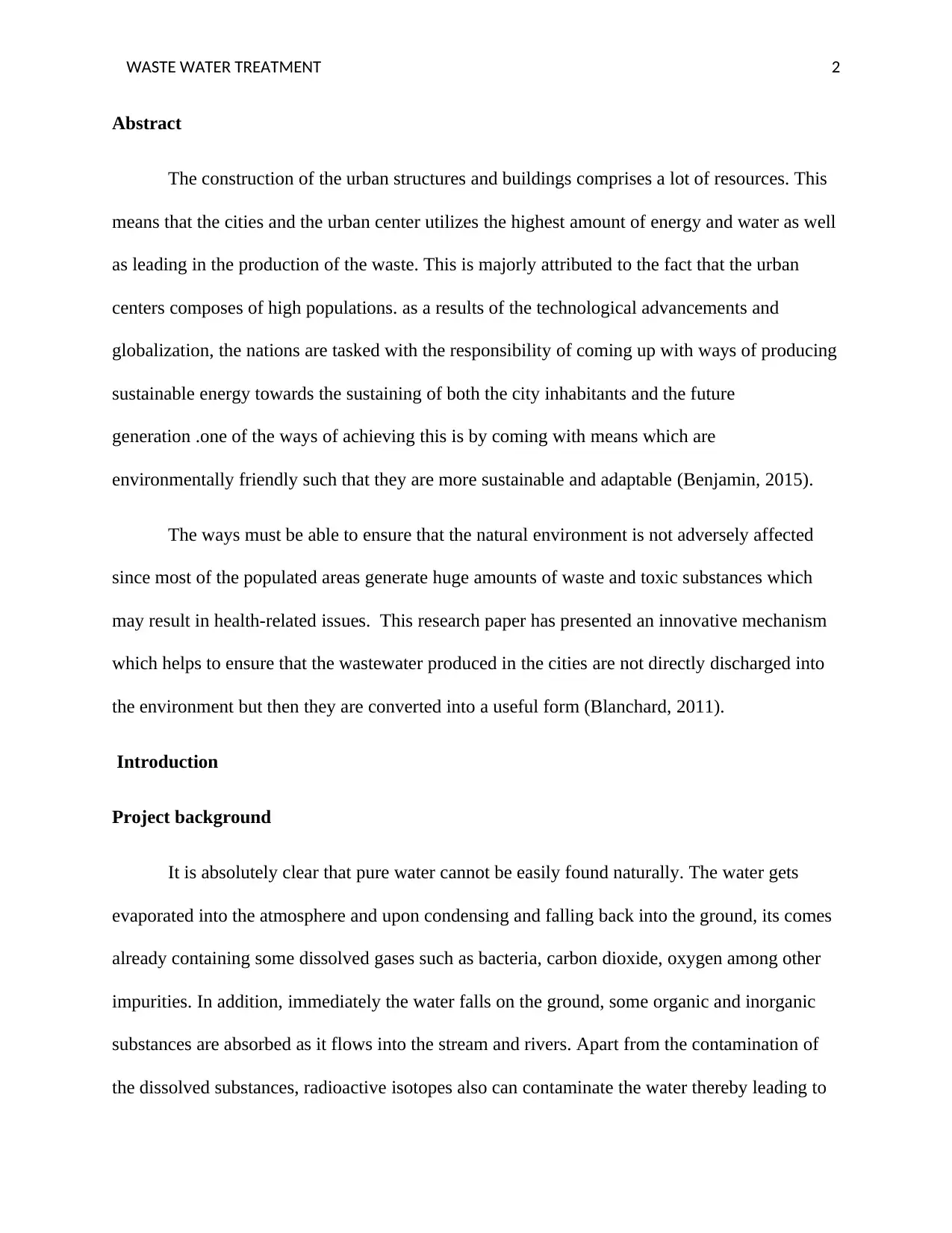
WASTE WATER TREATMENT 2
Abstract
The construction of the urban structures and buildings comprises a lot of resources. This
means that the cities and the urban center utilizes the highest amount of energy and water as well
as leading in the production of the waste. This is majorly attributed to the fact that the urban
centers composes of high populations. as a results of the technological advancements and
globalization, the nations are tasked with the responsibility of coming up with ways of producing
sustainable energy towards the sustaining of both the city inhabitants and the future
generation .one of the ways of achieving this is by coming with means which are
environmentally friendly such that they are more sustainable and adaptable (Benjamin, 2015).
The ways must be able to ensure that the natural environment is not adversely affected
since most of the populated areas generate huge amounts of waste and toxic substances which
may result in health-related issues. This research paper has presented an innovative mechanism
which helps to ensure that the wastewater produced in the cities are not directly discharged into
the environment but then they are converted into a useful form (Blanchard, 2011).
Introduction
Project background
It is absolutely clear that pure water cannot be easily found naturally. The water gets
evaporated into the atmosphere and upon condensing and falling back into the ground, its comes
already containing some dissolved gases such as bacteria, carbon dioxide, oxygen among other
impurities. In addition, immediately the water falls on the ground, some organic and inorganic
substances are absorbed as it flows into the stream and rivers. Apart from the contamination of
the dissolved substances, radioactive isotopes also can contaminate the water thereby leading to
Abstract
The construction of the urban structures and buildings comprises a lot of resources. This
means that the cities and the urban center utilizes the highest amount of energy and water as well
as leading in the production of the waste. This is majorly attributed to the fact that the urban
centers composes of high populations. as a results of the technological advancements and
globalization, the nations are tasked with the responsibility of coming up with ways of producing
sustainable energy towards the sustaining of both the city inhabitants and the future
generation .one of the ways of achieving this is by coming with means which are
environmentally friendly such that they are more sustainable and adaptable (Benjamin, 2015).
The ways must be able to ensure that the natural environment is not adversely affected
since most of the populated areas generate huge amounts of waste and toxic substances which
may result in health-related issues. This research paper has presented an innovative mechanism
which helps to ensure that the wastewater produced in the cities are not directly discharged into
the environment but then they are converted into a useful form (Blanchard, 2011).
Introduction
Project background
It is absolutely clear that pure water cannot be easily found naturally. The water gets
evaporated into the atmosphere and upon condensing and falling back into the ground, its comes
already containing some dissolved gases such as bacteria, carbon dioxide, oxygen among other
impurities. In addition, immediately the water falls on the ground, some organic and inorganic
substances are absorbed as it flows into the stream and rivers. Apart from the contamination of
the dissolved substances, radioactive isotopes also can contaminate the water thereby leading to
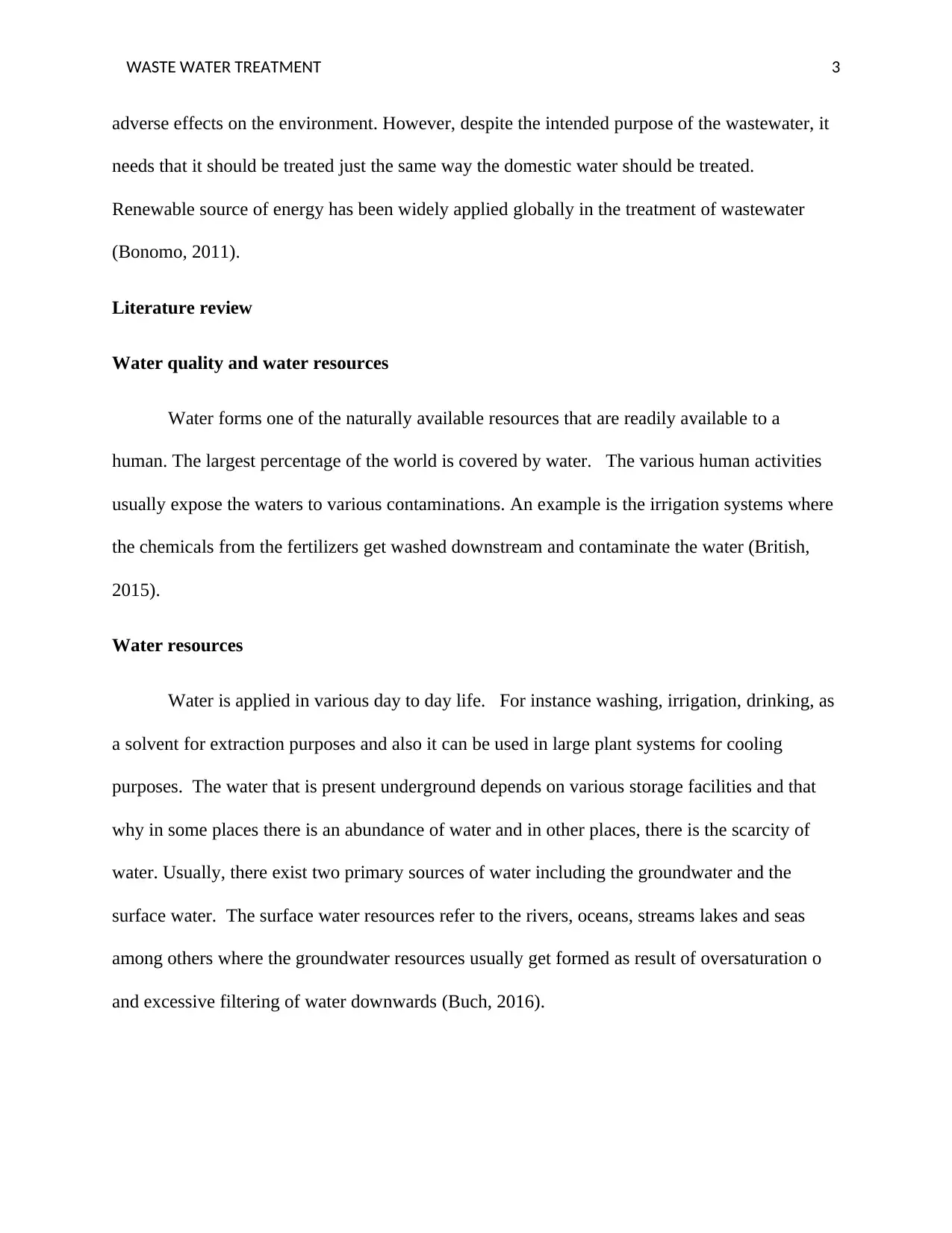
WASTE WATER TREATMENT 3
adverse effects on the environment. However, despite the intended purpose of the wastewater, it
needs that it should be treated just the same way the domestic water should be treated.
Renewable source of energy has been widely applied globally in the treatment of wastewater
(Bonomo, 2011).
Literature review
Water quality and water resources
Water forms one of the naturally available resources that are readily available to a
human. The largest percentage of the world is covered by water. The various human activities
usually expose the waters to various contaminations. An example is the irrigation systems where
the chemicals from the fertilizers get washed downstream and contaminate the water (British,
2015).
Water resources
Water is applied in various day to day life. For instance washing, irrigation, drinking, as
a solvent for extraction purposes and also it can be used in large plant systems for cooling
purposes. The water that is present underground depends on various storage facilities and that
why in some places there is an abundance of water and in other places, there is the scarcity of
water. Usually, there exist two primary sources of water including the groundwater and the
surface water. The surface water resources refer to the rivers, oceans, streams lakes and seas
among others where the groundwater resources usually get formed as result of oversaturation o
and excessive filtering of water downwards (Buch, 2016).
adverse effects on the environment. However, despite the intended purpose of the wastewater, it
needs that it should be treated just the same way the domestic water should be treated.
Renewable source of energy has been widely applied globally in the treatment of wastewater
(Bonomo, 2011).
Literature review
Water quality and water resources
Water forms one of the naturally available resources that are readily available to a
human. The largest percentage of the world is covered by water. The various human activities
usually expose the waters to various contaminations. An example is the irrigation systems where
the chemicals from the fertilizers get washed downstream and contaminate the water (British,
2015).
Water resources
Water is applied in various day to day life. For instance washing, irrigation, drinking, as
a solvent for extraction purposes and also it can be used in large plant systems for cooling
purposes. The water that is present underground depends on various storage facilities and that
why in some places there is an abundance of water and in other places, there is the scarcity of
water. Usually, there exist two primary sources of water including the groundwater and the
surface water. The surface water resources refer to the rivers, oceans, streams lakes and seas
among others where the groundwater resources usually get formed as result of oversaturation o
and excessive filtering of water downwards (Buch, 2016).
⊘ This is a preview!⊘
Do you want full access?
Subscribe today to unlock all pages.

Trusted by 1+ million students worldwide
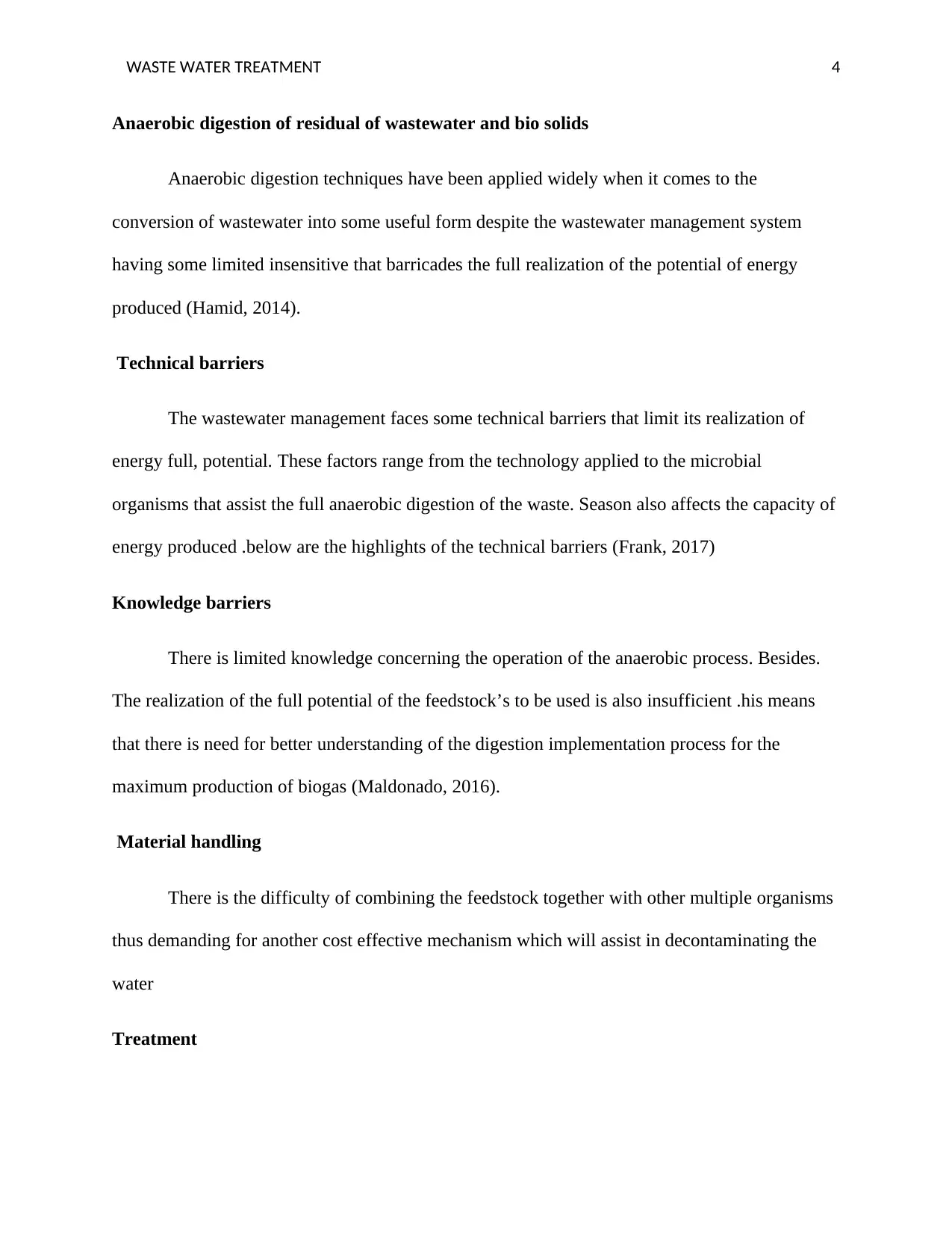
WASTE WATER TREATMENT 4
Anaerobic digestion of residual of wastewater and bio solids
Anaerobic digestion techniques have been applied widely when it comes to the
conversion of wastewater into some useful form despite the wastewater management system
having some limited insensitive that barricades the full realization of the potential of energy
produced (Hamid, 2014).
Technical barriers
The wastewater management faces some technical barriers that limit its realization of
energy full, potential. These factors range from the technology applied to the microbial
organisms that assist the full anaerobic digestion of the waste. Season also affects the capacity of
energy produced .below are the highlights of the technical barriers (Frank, 2017)
Knowledge barriers
There is limited knowledge concerning the operation of the anaerobic process. Besides.
The realization of the full potential of the feedstock’s to be used is also insufficient .his means
that there is need for better understanding of the digestion implementation process for the
maximum production of biogas (Maldonado, 2016).
Material handling
There is the difficulty of combining the feedstock together with other multiple organisms
thus demanding for another cost effective mechanism which will assist in decontaminating the
water
Treatment
Anaerobic digestion of residual of wastewater and bio solids
Anaerobic digestion techniques have been applied widely when it comes to the
conversion of wastewater into some useful form despite the wastewater management system
having some limited insensitive that barricades the full realization of the potential of energy
produced (Hamid, 2014).
Technical barriers
The wastewater management faces some technical barriers that limit its realization of
energy full, potential. These factors range from the technology applied to the microbial
organisms that assist the full anaerobic digestion of the waste. Season also affects the capacity of
energy produced .below are the highlights of the technical barriers (Frank, 2017)
Knowledge barriers
There is limited knowledge concerning the operation of the anaerobic process. Besides.
The realization of the full potential of the feedstock’s to be used is also insufficient .his means
that there is need for better understanding of the digestion implementation process for the
maximum production of biogas (Maldonado, 2016).
Material handling
There is the difficulty of combining the feedstock together with other multiple organisms
thus demanding for another cost effective mechanism which will assist in decontaminating the
water
Treatment
Paraphrase This Document
Need a fresh take? Get an instant paraphrase of this document with our AI Paraphraser
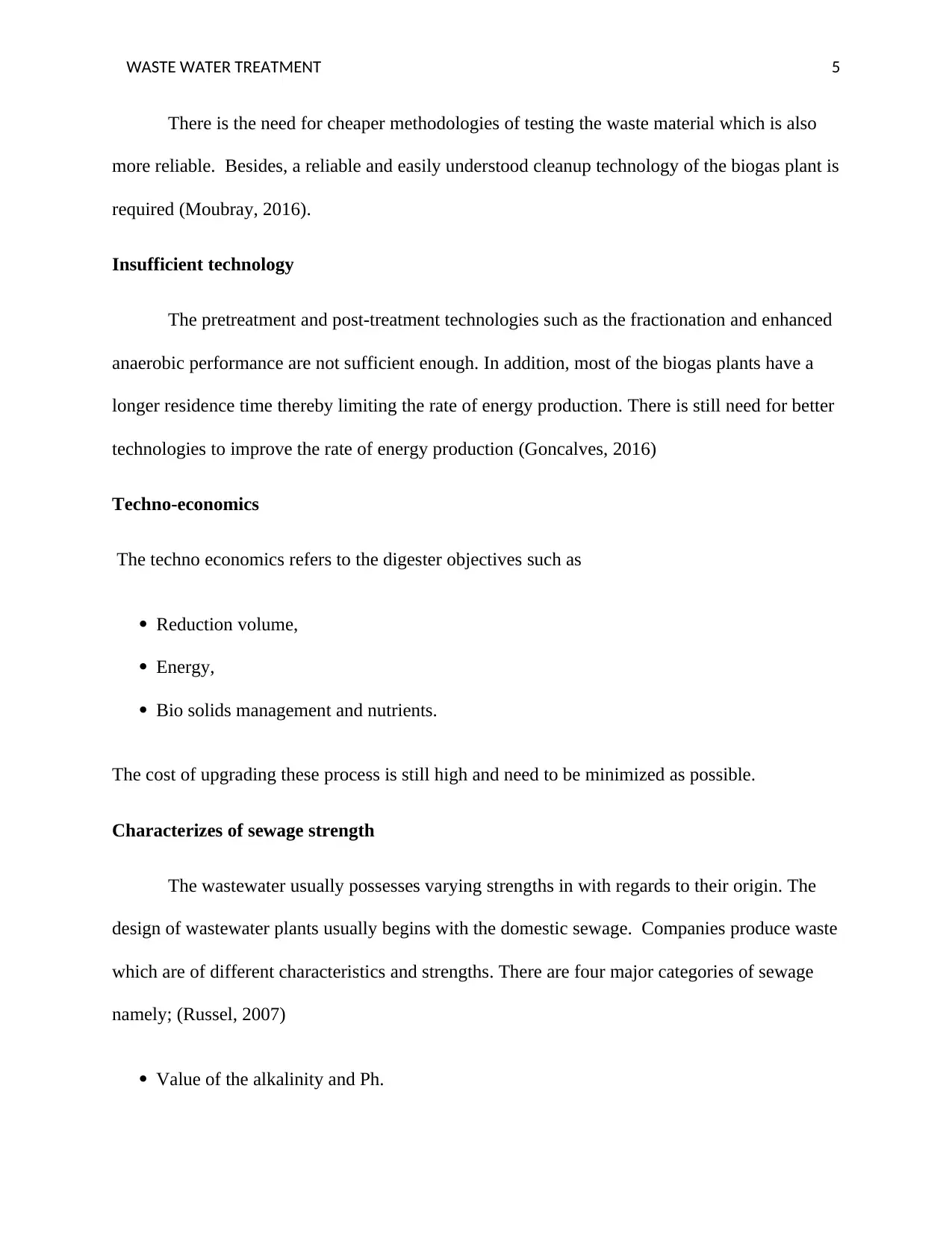
WASTE WATER TREATMENT 5
There is the need for cheaper methodologies of testing the waste material which is also
more reliable. Besides, a reliable and easily understood cleanup technology of the biogas plant is
required (Moubray, 2016).
Insufficient technology
The pretreatment and post-treatment technologies such as the fractionation and enhanced
anaerobic performance are not sufficient enough. In addition, most of the biogas plants have a
longer residence time thereby limiting the rate of energy production. There is still need for better
technologies to improve the rate of energy production (Goncalves, 2016)
Techno-economics
The techno economics refers to the digester objectives such as
Reduction volume,
Energy,
Bio solids management and nutrients.
The cost of upgrading these process is still high and need to be minimized as possible.
Characterizes of sewage strength
The wastewater usually possesses varying strengths in with regards to their origin. The
design of wastewater plants usually begins with the domestic sewage. Companies produce waste
which are of different characteristics and strengths. There are four major categories of sewage
namely; (Russel, 2007)
Value of the alkalinity and Ph.
There is the need for cheaper methodologies of testing the waste material which is also
more reliable. Besides, a reliable and easily understood cleanup technology of the biogas plant is
required (Moubray, 2016).
Insufficient technology
The pretreatment and post-treatment technologies such as the fractionation and enhanced
anaerobic performance are not sufficient enough. In addition, most of the biogas plants have a
longer residence time thereby limiting the rate of energy production. There is still need for better
technologies to improve the rate of energy production (Goncalves, 2016)
Techno-economics
The techno economics refers to the digester objectives such as
Reduction volume,
Energy,
Bio solids management and nutrients.
The cost of upgrading these process is still high and need to be minimized as possible.
Characterizes of sewage strength
The wastewater usually possesses varying strengths in with regards to their origin. The
design of wastewater plants usually begins with the domestic sewage. Companies produce waste
which are of different characteristics and strengths. There are four major categories of sewage
namely; (Russel, 2007)
Value of the alkalinity and Ph.
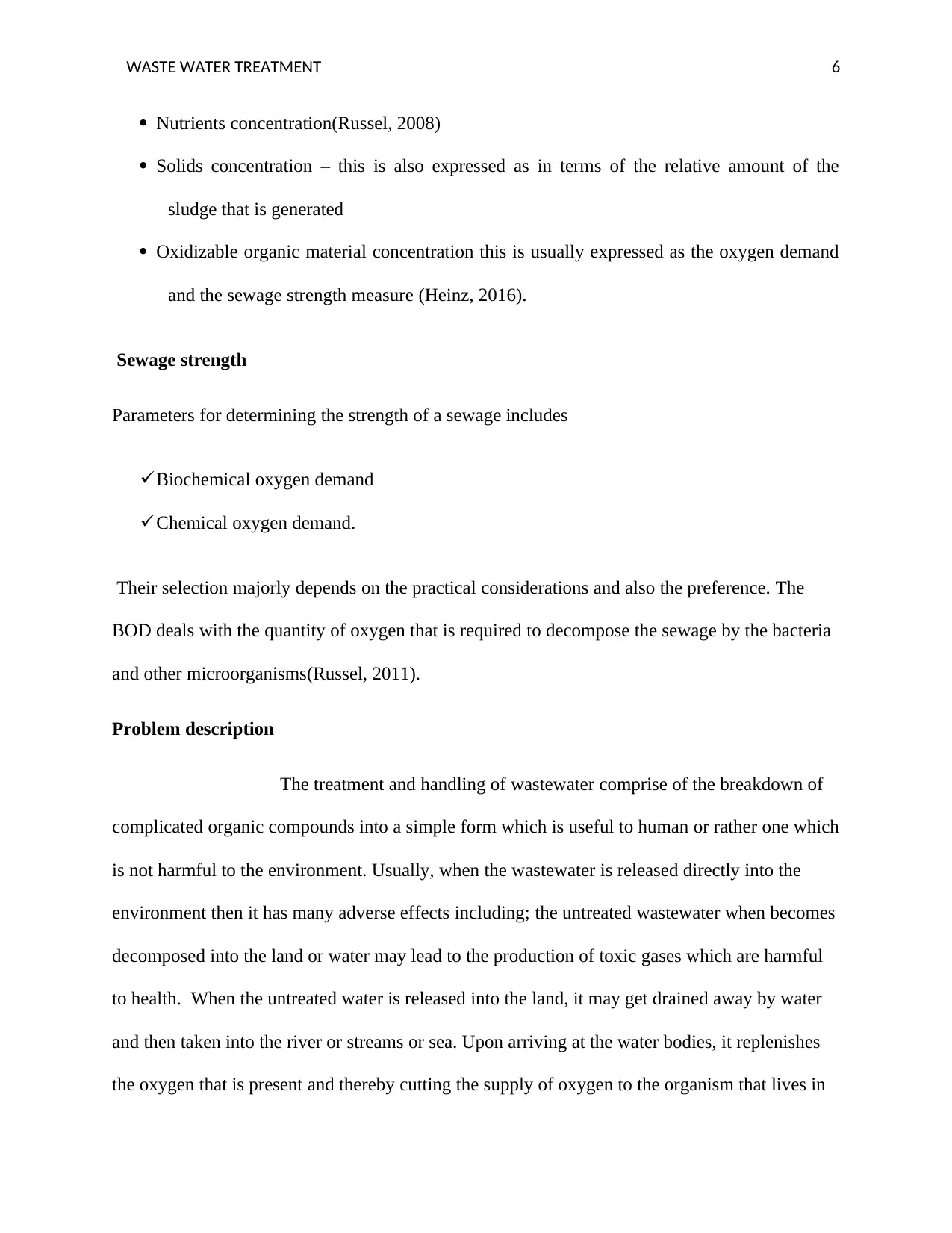
WASTE WATER TREATMENT 6
Nutrients concentration(Russel, 2008)
Solids concentration – this is also expressed as in terms of the relative amount of the
sludge that is generated
Oxidizable organic material concentration this is usually expressed as the oxygen demand
and the sewage strength measure (Heinz, 2016).
Sewage strength
Parameters for determining the strength of a sewage includes
Biochemical oxygen demand
Chemical oxygen demand.
Their selection majorly depends on the practical considerations and also the preference. The
BOD deals with the quantity of oxygen that is required to decompose the sewage by the bacteria
and other microorganisms(Russel, 2011).
Problem description
The treatment and handling of wastewater comprise of the breakdown of
complicated organic compounds into a simple form which is useful to human or rather one which
is not harmful to the environment. Usually, when the wastewater is released directly into the
environment then it has many adverse effects including; the untreated wastewater when becomes
decomposed into the land or water may lead to the production of toxic gases which are harmful
to health. When the untreated water is released into the land, it may get drained away by water
and then taken into the river or streams or sea. Upon arriving at the water bodies, it replenishes
the oxygen that is present and thereby cutting the supply of oxygen to the organism that lives in
Nutrients concentration(Russel, 2008)
Solids concentration – this is also expressed as in terms of the relative amount of the
sludge that is generated
Oxidizable organic material concentration this is usually expressed as the oxygen demand
and the sewage strength measure (Heinz, 2016).
Sewage strength
Parameters for determining the strength of a sewage includes
Biochemical oxygen demand
Chemical oxygen demand.
Their selection majorly depends on the practical considerations and also the preference. The
BOD deals with the quantity of oxygen that is required to decompose the sewage by the bacteria
and other microorganisms(Russel, 2011).
Problem description
The treatment and handling of wastewater comprise of the breakdown of
complicated organic compounds into a simple form which is useful to human or rather one which
is not harmful to the environment. Usually, when the wastewater is released directly into the
environment then it has many adverse effects including; the untreated wastewater when becomes
decomposed into the land or water may lead to the production of toxic gases which are harmful
to health. When the untreated water is released into the land, it may get drained away by water
and then taken into the river or streams or sea. Upon arriving at the water bodies, it replenishes
the oxygen that is present and thereby cutting the supply of oxygen to the organism that lives in
⊘ This is a preview!⊘
Do you want full access?
Subscribe today to unlock all pages.

Trusted by 1+ million students worldwide
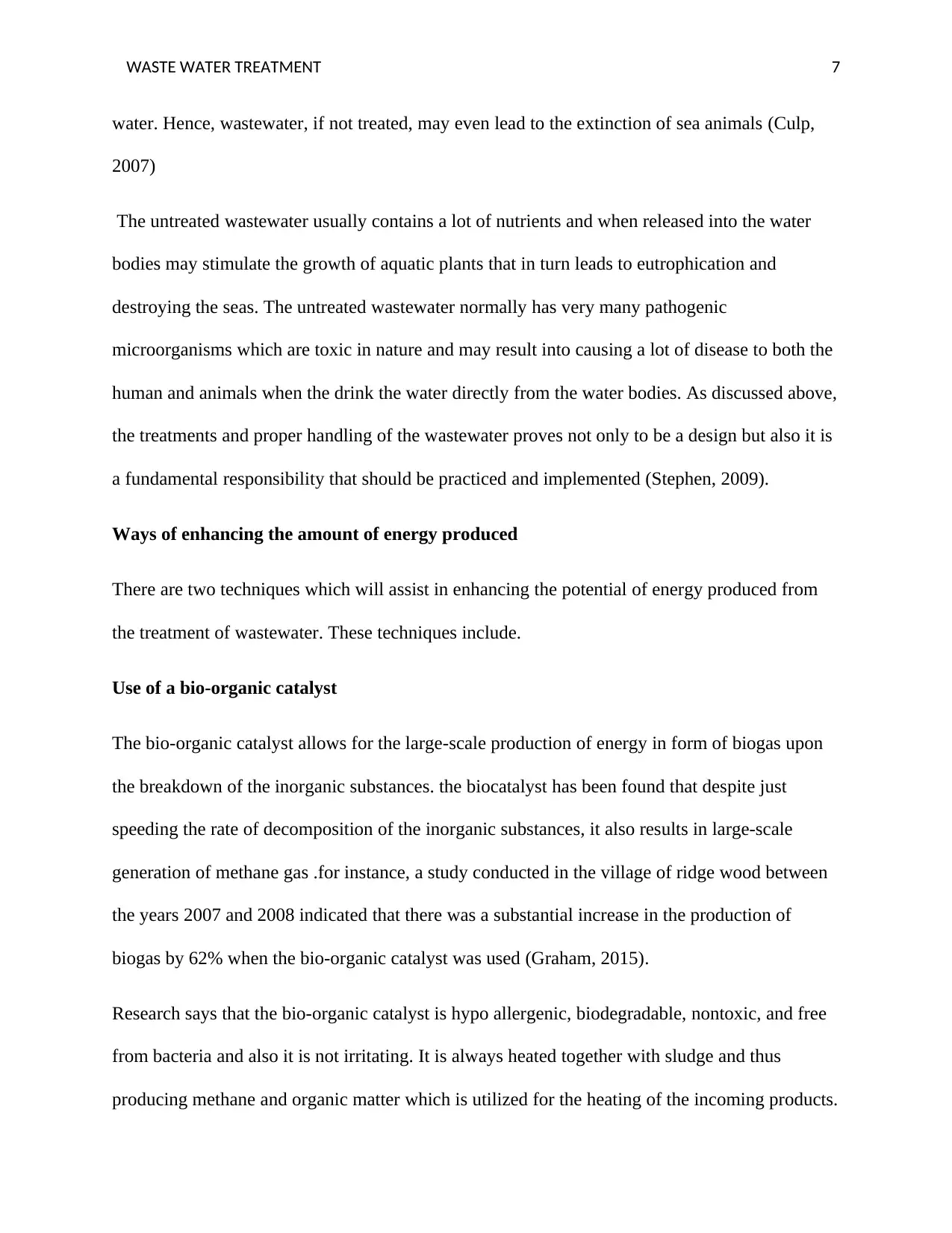
WASTE WATER TREATMENT 7
water. Hence, wastewater, if not treated, may even lead to the extinction of sea animals (Culp,
2007)
The untreated wastewater usually contains a lot of nutrients and when released into the water
bodies may stimulate the growth of aquatic plants that in turn leads to eutrophication and
destroying the seas. The untreated wastewater normally has very many pathogenic
microorganisms which are toxic in nature and may result into causing a lot of disease to both the
human and animals when the drink the water directly from the water bodies. As discussed above,
the treatments and proper handling of the wastewater proves not only to be a design but also it is
a fundamental responsibility that should be practiced and implemented (Stephen, 2009).
Ways of enhancing the amount of energy produced
There are two techniques which will assist in enhancing the potential of energy produced from
the treatment of wastewater. These techniques include.
Use of a bio-organic catalyst
The bio-organic catalyst allows for the large-scale production of energy in form of biogas upon
the breakdown of the inorganic substances. the biocatalyst has been found that despite just
speeding the rate of decomposition of the inorganic substances, it also results in large-scale
generation of methane gas .for instance, a study conducted in the village of ridge wood between
the years 2007 and 2008 indicated that there was a substantial increase in the production of
biogas by 62% when the bio-organic catalyst was used (Graham, 2015).
Research says that the bio-organic catalyst is hypo allergenic, biodegradable, nontoxic, and free
from bacteria and also it is not irritating. It is always heated together with sludge and thus
producing methane and organic matter which is utilized for the heating of the incoming products.
water. Hence, wastewater, if not treated, may even lead to the extinction of sea animals (Culp,
2007)
The untreated wastewater usually contains a lot of nutrients and when released into the water
bodies may stimulate the growth of aquatic plants that in turn leads to eutrophication and
destroying the seas. The untreated wastewater normally has very many pathogenic
microorganisms which are toxic in nature and may result into causing a lot of disease to both the
human and animals when the drink the water directly from the water bodies. As discussed above,
the treatments and proper handling of the wastewater proves not only to be a design but also it is
a fundamental responsibility that should be practiced and implemented (Stephen, 2009).
Ways of enhancing the amount of energy produced
There are two techniques which will assist in enhancing the potential of energy produced from
the treatment of wastewater. These techniques include.
Use of a bio-organic catalyst
The bio-organic catalyst allows for the large-scale production of energy in form of biogas upon
the breakdown of the inorganic substances. the biocatalyst has been found that despite just
speeding the rate of decomposition of the inorganic substances, it also results in large-scale
generation of methane gas .for instance, a study conducted in the village of ridge wood between
the years 2007 and 2008 indicated that there was a substantial increase in the production of
biogas by 62% when the bio-organic catalyst was used (Graham, 2015).
Research says that the bio-organic catalyst is hypo allergenic, biodegradable, nontoxic, and free
from bacteria and also it is not irritating. It is always heated together with sludge and thus
producing methane and organic matter which is utilized for the heating of the incoming products.
Paraphrase This Document
Need a fresh take? Get an instant paraphrase of this document with our AI Paraphraser
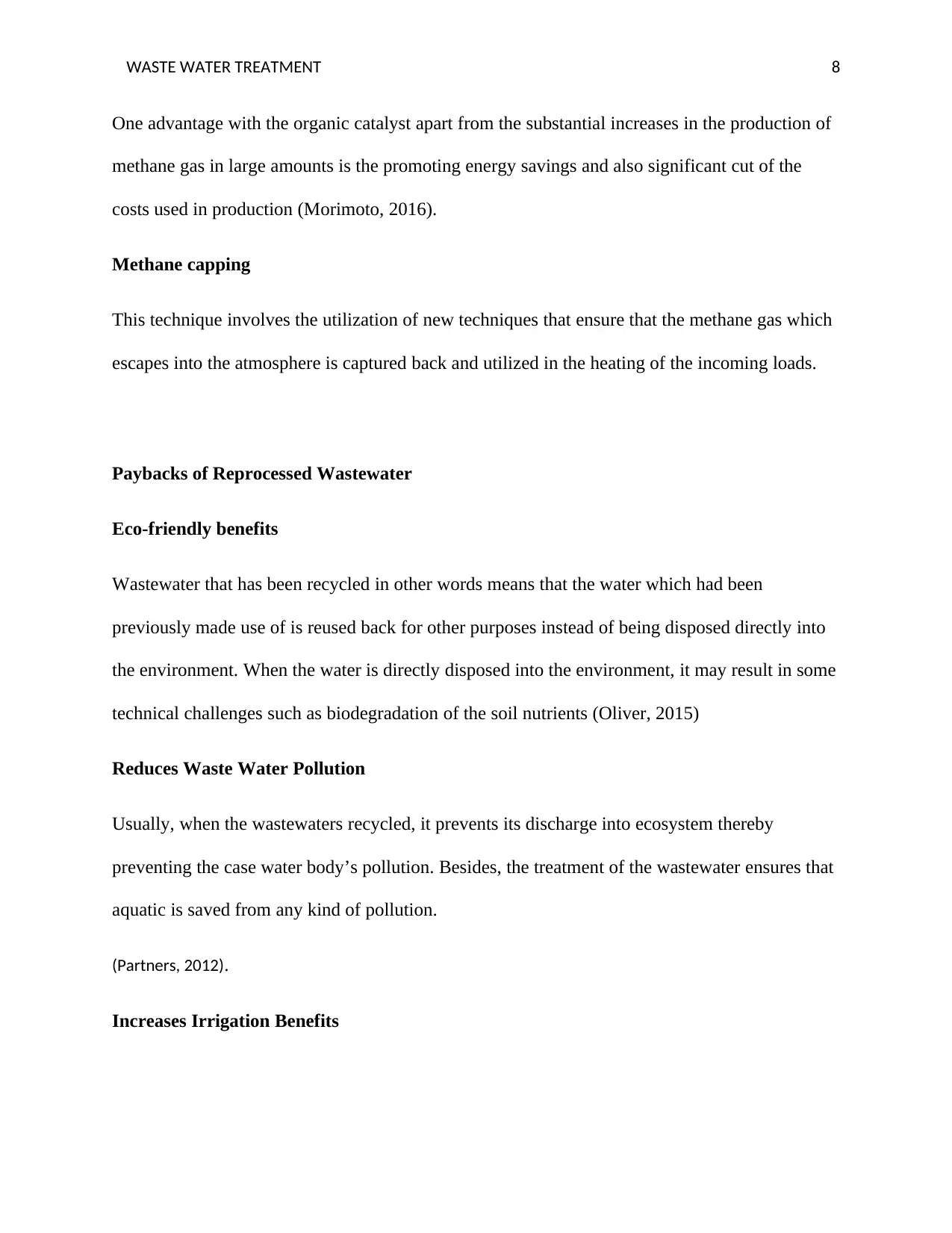
WASTE WATER TREATMENT 8
One advantage with the organic catalyst apart from the substantial increases in the production of
methane gas in large amounts is the promoting energy savings and also significant cut of the
costs used in production (Morimoto, 2016).
Methane capping
This technique involves the utilization of new techniques that ensure that the methane gas which
escapes into the atmosphere is captured back and utilized in the heating of the incoming loads.
Paybacks of Reprocessed Wastewater
Eco-friendly benefits
Wastewater that has been recycled in other words means that the water which had been
previously made use of is reused back for other purposes instead of being disposed directly into
the environment. When the water is directly disposed into the environment, it may result in some
technical challenges such as biodegradation of the soil nutrients (Oliver, 2015)
Reduces Waste Water Pollution
Usually, when the wastewaters recycled, it prevents its discharge into ecosystem thereby
preventing the case water body’s pollution. Besides, the treatment of the wastewater ensures that
aquatic is saved from any kind of pollution.
(Partners, 2012).
Increases Irrigation Benefits
One advantage with the organic catalyst apart from the substantial increases in the production of
methane gas in large amounts is the promoting energy savings and also significant cut of the
costs used in production (Morimoto, 2016).
Methane capping
This technique involves the utilization of new techniques that ensure that the methane gas which
escapes into the atmosphere is captured back and utilized in the heating of the incoming loads.
Paybacks of Reprocessed Wastewater
Eco-friendly benefits
Wastewater that has been recycled in other words means that the water which had been
previously made use of is reused back for other purposes instead of being disposed directly into
the environment. When the water is directly disposed into the environment, it may result in some
technical challenges such as biodegradation of the soil nutrients (Oliver, 2015)
Reduces Waste Water Pollution
Usually, when the wastewaters recycled, it prevents its discharge into ecosystem thereby
preventing the case water body’s pollution. Besides, the treatment of the wastewater ensures that
aquatic is saved from any kind of pollution.
(Partners, 2012).
Increases Irrigation Benefits
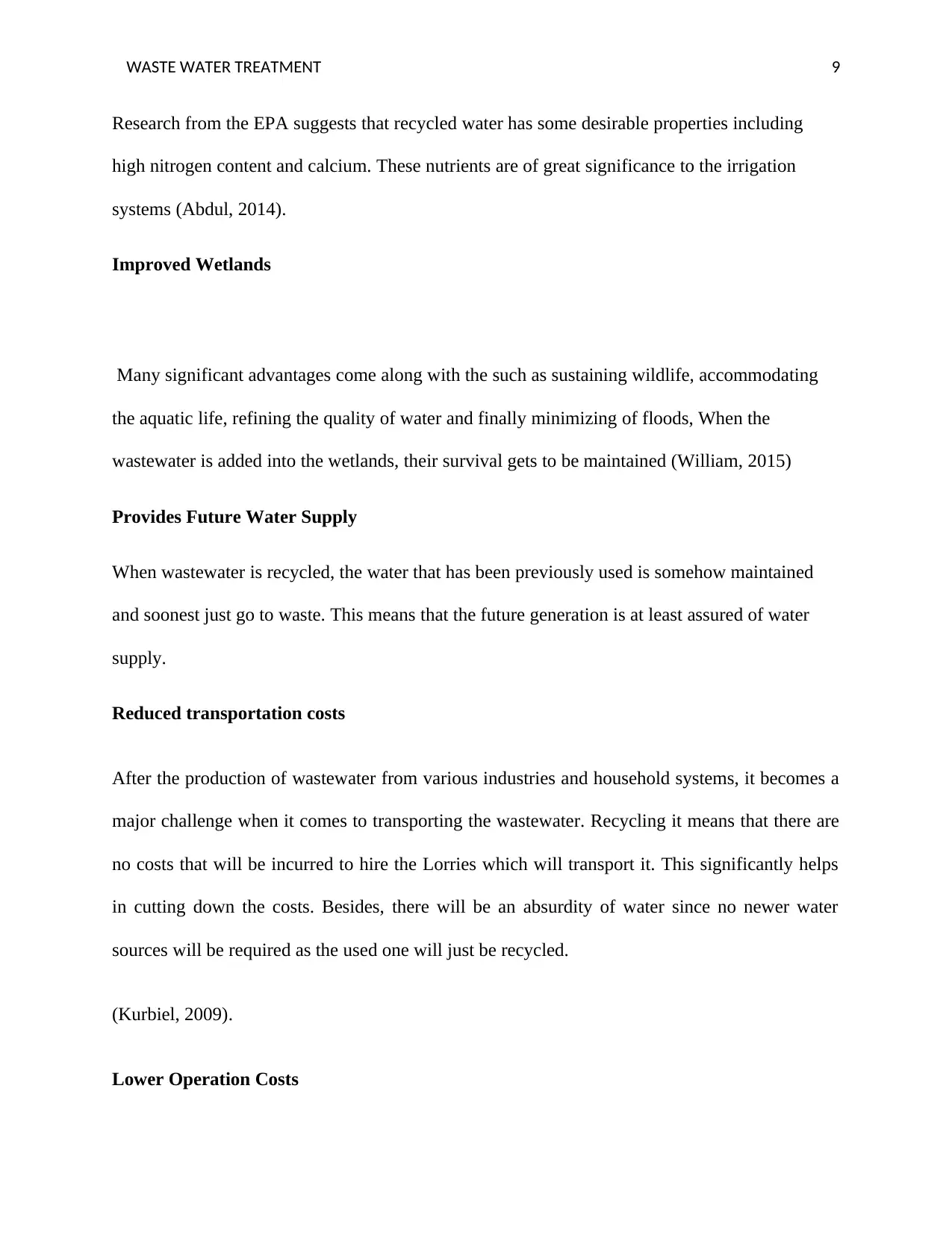
WASTE WATER TREATMENT 9
Research from the EPA suggests that recycled water has some desirable properties including
high nitrogen content and calcium. These nutrients are of great significance to the irrigation
systems (Abdul, 2014).
Improved Wetlands
Many significant advantages come along with the such as sustaining wildlife, accommodating
the aquatic life, refining the quality of water and finally minimizing of floods, When the
wastewater is added into the wetlands, their survival gets to be maintained (William, 2015)
Provides Future Water Supply
When wastewater is recycled, the water that has been previously used is somehow maintained
and soonest just go to waste. This means that the future generation is at least assured of water
supply.
Reduced transportation costs
After the production of wastewater from various industries and household systems, it becomes a
major challenge when it comes to transporting the wastewater. Recycling it means that there are
no costs that will be incurred to hire the Lorries which will transport it. This significantly helps
in cutting down the costs. Besides, there will be an absurdity of water since no newer water
sources will be required as the used one will just be recycled.
(Kurbiel, 2009).
Lower Operation Costs
Research from the EPA suggests that recycled water has some desirable properties including
high nitrogen content and calcium. These nutrients are of great significance to the irrigation
systems (Abdul, 2014).
Improved Wetlands
Many significant advantages come along with the such as sustaining wildlife, accommodating
the aquatic life, refining the quality of water and finally minimizing of floods, When the
wastewater is added into the wetlands, their survival gets to be maintained (William, 2015)
Provides Future Water Supply
When wastewater is recycled, the water that has been previously used is somehow maintained
and soonest just go to waste. This means that the future generation is at least assured of water
supply.
Reduced transportation costs
After the production of wastewater from various industries and household systems, it becomes a
major challenge when it comes to transporting the wastewater. Recycling it means that there are
no costs that will be incurred to hire the Lorries which will transport it. This significantly helps
in cutting down the costs. Besides, there will be an absurdity of water since no newer water
sources will be required as the used one will just be recycled.
(Kurbiel, 2009).
Lower Operation Costs
⊘ This is a preview!⊘
Do you want full access?
Subscribe today to unlock all pages.

Trusted by 1+ million students worldwide
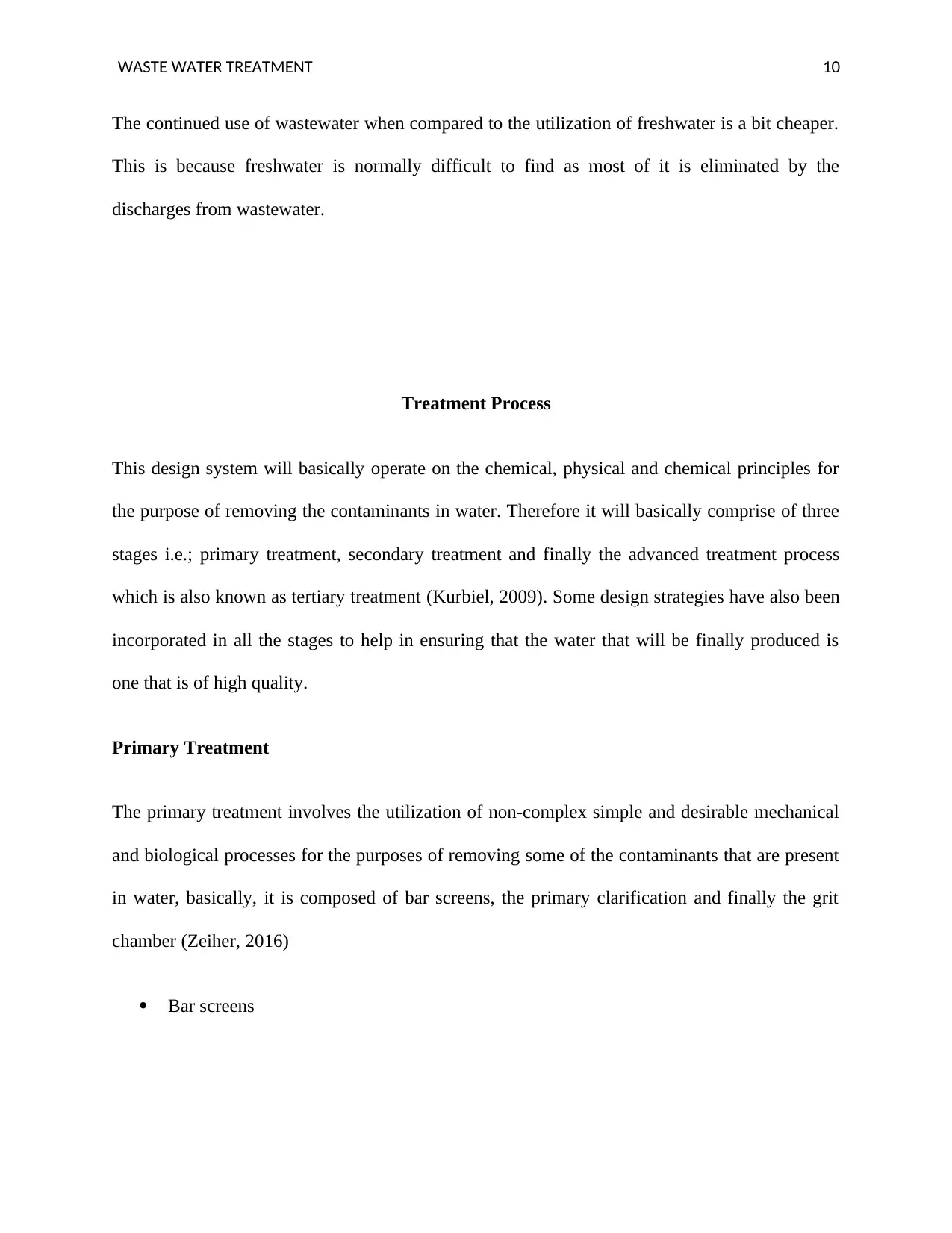
WASTE WATER TREATMENT 10
The continued use of wastewater when compared to the utilization of freshwater is a bit cheaper.
This is because freshwater is normally difficult to find as most of it is eliminated by the
discharges from wastewater.
Treatment Process
This design system will basically operate on the chemical, physical and chemical principles for
the purpose of removing the contaminants in water. Therefore it will basically comprise of three
stages i.e.; primary treatment, secondary treatment and finally the advanced treatment process
which is also known as tertiary treatment (Kurbiel, 2009). Some design strategies have also been
incorporated in all the stages to help in ensuring that the water that will be finally produced is
one that is of high quality.
Primary Treatment
The primary treatment involves the utilization of non-complex simple and desirable mechanical
and biological processes for the purposes of removing some of the contaminants that are present
in water, basically, it is composed of bar screens, the primary clarification and finally the grit
chamber (Zeiher, 2016)
Bar screens
The continued use of wastewater when compared to the utilization of freshwater is a bit cheaper.
This is because freshwater is normally difficult to find as most of it is eliminated by the
discharges from wastewater.
Treatment Process
This design system will basically operate on the chemical, physical and chemical principles for
the purpose of removing the contaminants in water. Therefore it will basically comprise of three
stages i.e.; primary treatment, secondary treatment and finally the advanced treatment process
which is also known as tertiary treatment (Kurbiel, 2009). Some design strategies have also been
incorporated in all the stages to help in ensuring that the water that will be finally produced is
one that is of high quality.
Primary Treatment
The primary treatment involves the utilization of non-complex simple and desirable mechanical
and biological processes for the purposes of removing some of the contaminants that are present
in water, basically, it is composed of bar screens, the primary clarification and finally the grit
chamber (Zeiher, 2016)
Bar screens
Paraphrase This Document
Need a fresh take? Get an instant paraphrase of this document with our AI Paraphraser
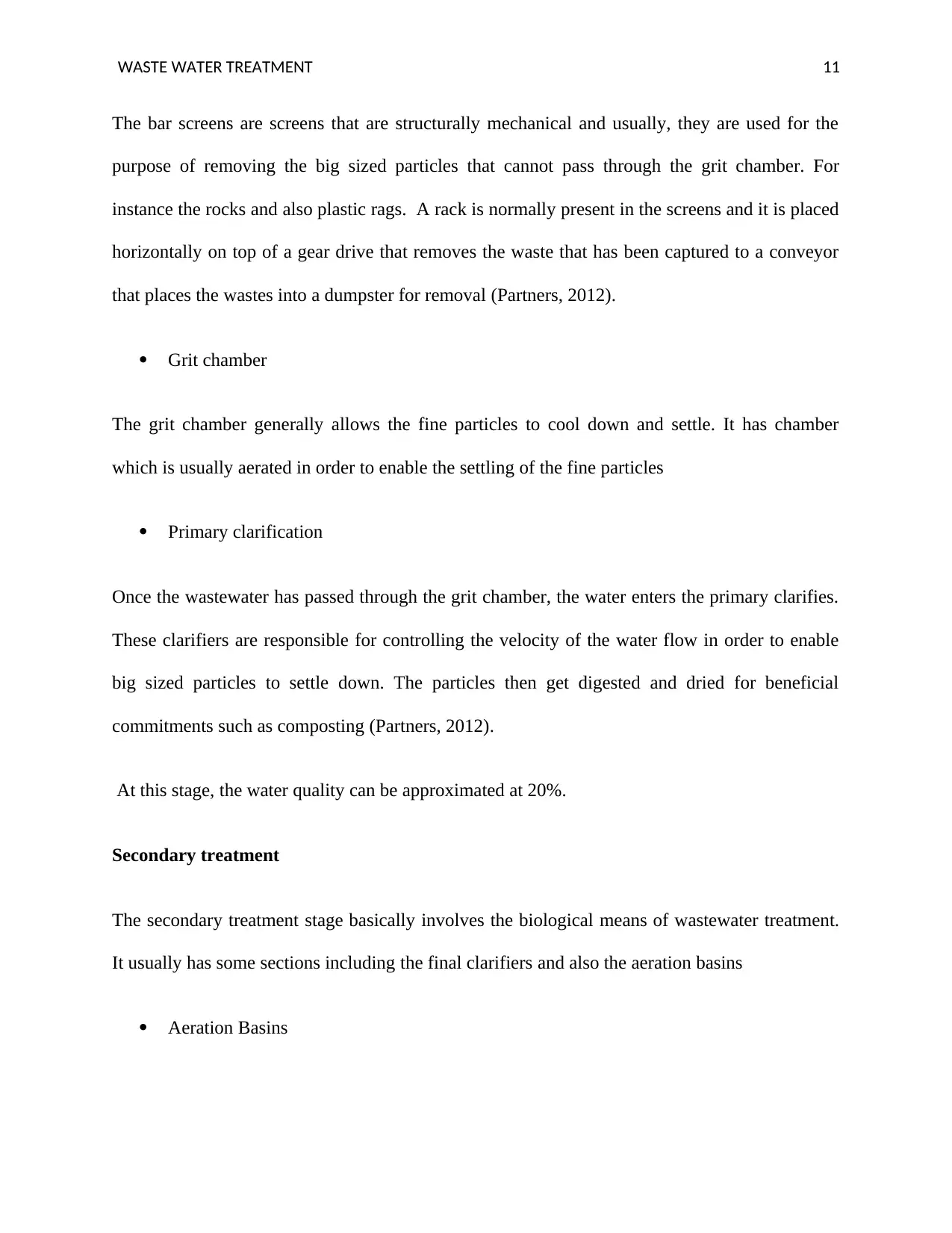
WASTE WATER TREATMENT 11
The bar screens are screens that are structurally mechanical and usually, they are used for the
purpose of removing the big sized particles that cannot pass through the grit chamber. For
instance the rocks and also plastic rags. A rack is normally present in the screens and it is placed
horizontally on top of a gear drive that removes the waste that has been captured to a conveyor
that places the wastes into a dumpster for removal (Partners, 2012).
Grit chamber
The grit chamber generally allows the fine particles to cool down and settle. It has chamber
which is usually aerated in order to enable the settling of the fine particles
Primary clarification
Once the wastewater has passed through the grit chamber, the water enters the primary clarifies.
These clarifiers are responsible for controlling the velocity of the water flow in order to enable
big sized particles to settle down. The particles then get digested and dried for beneficial
commitments such as composting (Partners, 2012).
At this stage, the water quality can be approximated at 20%.
Secondary treatment
The secondary treatment stage basically involves the biological means of wastewater treatment.
It usually has some sections including the final clarifiers and also the aeration basins
Aeration Basins
The bar screens are screens that are structurally mechanical and usually, they are used for the
purpose of removing the big sized particles that cannot pass through the grit chamber. For
instance the rocks and also plastic rags. A rack is normally present in the screens and it is placed
horizontally on top of a gear drive that removes the waste that has been captured to a conveyor
that places the wastes into a dumpster for removal (Partners, 2012).
Grit chamber
The grit chamber generally allows the fine particles to cool down and settle. It has chamber
which is usually aerated in order to enable the settling of the fine particles
Primary clarification
Once the wastewater has passed through the grit chamber, the water enters the primary clarifies.
These clarifiers are responsible for controlling the velocity of the water flow in order to enable
big sized particles to settle down. The particles then get digested and dried for beneficial
commitments such as composting (Partners, 2012).
At this stage, the water quality can be approximated at 20%.
Secondary treatment
The secondary treatment stage basically involves the biological means of wastewater treatment.
It usually has some sections including the final clarifiers and also the aeration basins
Aeration Basins
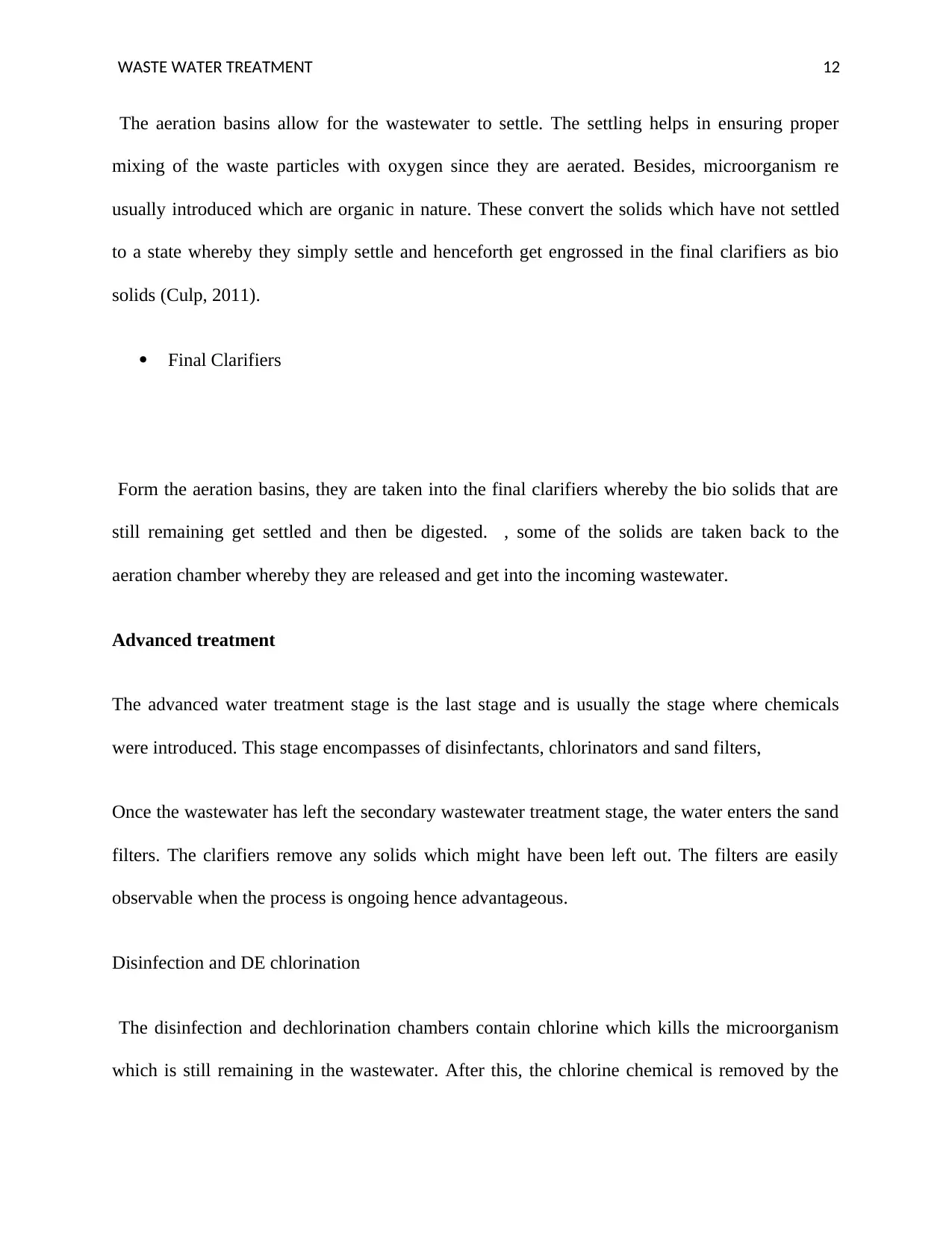
WASTE WATER TREATMENT 12
The aeration basins allow for the wastewater to settle. The settling helps in ensuring proper
mixing of the waste particles with oxygen since they are aerated. Besides, microorganism re
usually introduced which are organic in nature. These convert the solids which have not settled
to a state whereby they simply settle and henceforth get engrossed in the final clarifiers as bio
solids (Culp, 2011).
Final Clarifiers
Form the aeration basins, they are taken into the final clarifiers whereby the bio solids that are
still remaining get settled and then be digested. , some of the solids are taken back to the
aeration chamber whereby they are released and get into the incoming wastewater.
Advanced treatment
The advanced water treatment stage is the last stage and is usually the stage where chemicals
were introduced. This stage encompasses of disinfectants, chlorinators and sand filters,
Once the wastewater has left the secondary wastewater treatment stage, the water enters the sand
filters. The clarifiers remove any solids which might have been left out. The filters are easily
observable when the process is ongoing hence advantageous.
Disinfection and DE chlorination
The disinfection and dechlorination chambers contain chlorine which kills the microorganism
which is still remaining in the wastewater. After this, the chlorine chemical is removed by the
The aeration basins allow for the wastewater to settle. The settling helps in ensuring proper
mixing of the waste particles with oxygen since they are aerated. Besides, microorganism re
usually introduced which are organic in nature. These convert the solids which have not settled
to a state whereby they simply settle and henceforth get engrossed in the final clarifiers as bio
solids (Culp, 2011).
Final Clarifiers
Form the aeration basins, they are taken into the final clarifiers whereby the bio solids that are
still remaining get settled and then be digested. , some of the solids are taken back to the
aeration chamber whereby they are released and get into the incoming wastewater.
Advanced treatment
The advanced water treatment stage is the last stage and is usually the stage where chemicals
were introduced. This stage encompasses of disinfectants, chlorinators and sand filters,
Once the wastewater has left the secondary wastewater treatment stage, the water enters the sand
filters. The clarifiers remove any solids which might have been left out. The filters are easily
observable when the process is ongoing hence advantageous.
Disinfection and DE chlorination
The disinfection and dechlorination chambers contain chlorine which kills the microorganism
which is still remaining in the wastewater. After this, the chlorine chemical is removed by the
⊘ This is a preview!⊘
Do you want full access?
Subscribe today to unlock all pages.

Trusted by 1+ million students worldwide
1 out of 31
Related Documents
Your All-in-One AI-Powered Toolkit for Academic Success.
+13062052269
info@desklib.com
Available 24*7 on WhatsApp / Email
![[object Object]](/_next/static/media/star-bottom.7253800d.svg)
Unlock your academic potential
Copyright © 2020–2025 A2Z Services. All Rights Reserved. Developed and managed by ZUCOL.





